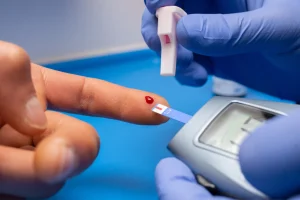When managing diabetes, fruits often raise questions because of their natural sugar content. Pineapple, with its tropical sweetness, is one of those fruits people often wonder about.
Is pineapple good for diabetes, or does it spike blood sugar too much?
The short answer: yes, pineapple can be part of a diabetes-friendly diet, but only in small portions and with careful pairing. Let’s break it down.
Why Fruits Matter in Diabetes?
Fruits provide fibre, vitamins, minerals, and antioxidants that support overall health. For people with diabetes, the key challenge is balancing their natural sugars with blood sugar control.
Some fruits have a sharper impact than others. Pineapple, being higher on the sweetness scale, needs special attention to portion size.
Pineapple Nutrition (per 100 g)
| Nutrient | Value | Benefit for Diabetes |
|---|---|---|
| Energy | 50 kcal | Moderate calories |
| Carbs | 13 g | Higher natural sugar load |
| Fiber | 1.4 g | Slows sugar absorption |
| Vitamin C | 47.8 mg | Reduces oxidative stress |
| Manganese | 0.9 mg | Supports metabolism & bone health |
| Potassium | 109 mg | Helps heart health |
Source: Food Struct
Why Pineapple Can Work for Diabetes (in Moderation)?
- Medium to High Glycemic Index (GI ~59): Pineapple has a GI in the medium-to-high range, meaning it can raise blood sugar faster than lower GI fruits. The glycemic load (GL) of a small serving, however, is moderate, making portion size critical.
- Antioxidant Powerhouse: Rich in vitamin C and manganese, pineapple helps fight oxidative stress and supports immunity.
- Bromelain Enzyme: Pineapple contains bromelain, a natural enzyme that supports digestion and may reduce inflammation.
- Hydrating & Refreshing: With high water content and natural sweetness, pineapple is a light, satisfying fruit when consumed smartly.
Benefits of Pineapple for People with Diabetes
- Supports Digestion: Bromelain aids in breaking down proteins and may support gut health.
- Antioxidant Protection: Vitamin C helps combat oxidative stress linked to diabetes complications.
- Hydration & Satiety: High water content makes it filling without being too calorie-heavy.
- Heart-Friendly Nutrients: Potassium and fibre support heart health, especially important for people with diabetes.
The Science in Simple Words
- Pineapple’s natural sugar can raise glucose quickly.
- Fibre and water content slow things down, but portion size matters.
- Small servings (½ cup) are usually fine, especially when paired with protein or fat.
- Pineapple isn’t “off-limits,” but moderation is key.
How to Eat Pineapple Safely with Diabetes?
- Control Portions: Stick to ½ cup of fresh pineapple (~50–60 g) per serving.
- Pair Smartly: Eat with yogurt, paneer, or nuts to slow sugar absorption.
- Avoid Juice & Canned Pineapple: These remove fiber and often add sugar, leading to rapid spikes.
- Time It Right: Best consumed earlier in the day or before physical activity.
- Test Your Response: Track with a glucometer or a GoodFlip CGM to see how your body reacts.
Pineapple in a Diabetes-Friendly Plate
Following the plate method:
- ½ plate: non-starchy vegetables
- ¼ plate: lean protein
- ¼ plate: whole grains
- Small side: fruit
Example:
- 1 chapati with sabzi (non-starchy vegetables)
- 1 bowl of dal
- Small side of pineapple slices as dessert
Who Should Be Extra Cautious?
- People with high post-meal sugar spikes.
- Those on insulin: Pineapple can raise glucose quickly if eaten alone.
- People with mouth ulcers or gastritis: pineapple’s acidity may aggravate symptoms.
- Kidney patients needing potassium restriction.
If Pineapple Doesn’t Work for You
If pineapple causes spikes, swap it for lower GI options.
Other Diabetes-Friendly Fruits
- Guava: very low GI, high fiber
- Berries: low sugar, antioxidant-rich
- Apple or Pear: moderate GI, high soluble fiber
- Kiwi: medium GI, refreshing and nutrient-rich
Non-Fruit Alternatives
- Chia seed pudding
- Paneer cubes with cucumber
- Greek yogurt with almonds
- Boiled chickpeas with lemon
Pineapple vs Other Tropical Fruits
| Fruit | GI (approx.) | Notes |
| Pineapple | 59 | Portion control needed |
| Papaya | 38–60 | Easier on glucose |
| Banana | 51–62 | Best when slightly green |
| Mango | 51–56 | High sugar, small portions |
| Watermelon | 72 | High GI, always pair with protein |
Myths About Pineapple and Diabetes
“Pineapple is too sweet and diabetics must avoid it.”
- Not true. Small portions are fine when paired smartly.
“Canned pineapple is as good as fresh.”
- Wrong. Canned versions often contain added sugar and syrup. Always choose fresh.
“Pineapple raises sugar the same way for everyone.”
- Not true. Individual responses vary. Use a CGM or glucometer to check.
Key Takeaways
- Pineapple can be included in a diabetes diet, but portion control is non-negotiable.
- Benefits: antioxidants, digestion support, hydration, and heart protection.
- Stick to ½ cup fresh pineapple, avoid juice or canned versions, and pair with protein/fats.
- Monitor your personal response with a glucometer or GoodFlip CGM.
Conclusion
Pineapple isn’t a forbidden fruit for diabetes. It’s a fruit that requires smart management. With small servings, mindful pairing, and personal tracking, pineapple can bring both sweetness and nutrition to a balanced diabetes-friendly plate.









